Modern buildings love glass walls, so choosing the right glass to manage sunlight is a huge deal. Too much sun can turn rooms into saunas, crank up cooling costs, and wreck things like curtains or floors. GLASVUE, with over 25 years of expertise, crafts awesome products like Low-E glass, insulated glass, and laminated glass. This guide dives into the best glass types for taming sunlight, using real-world project know-how, and shows how they stand out in today’s architecture.
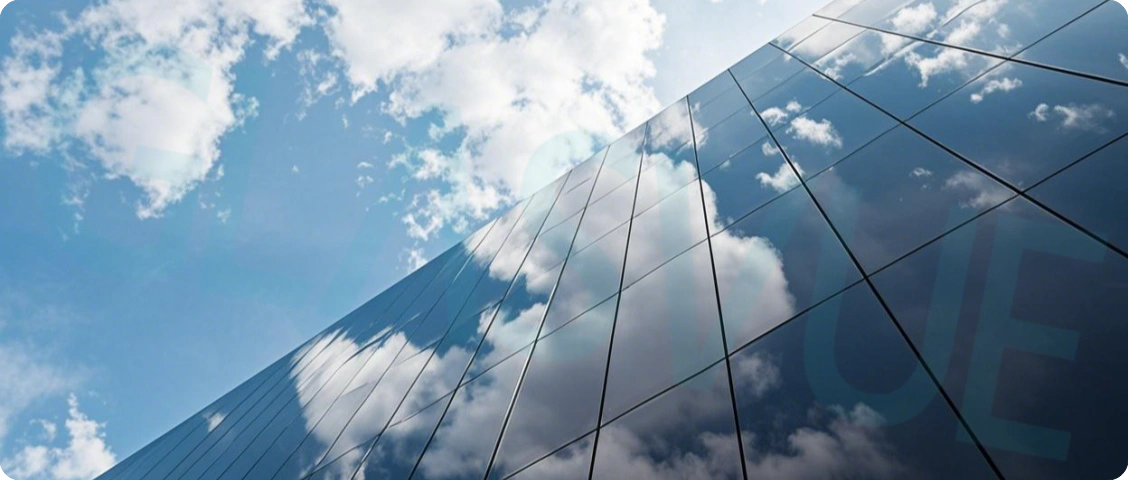
Why Controlling Sunlight Matters in Buildings
Why Blocking Extra Sunlight Is a Must
Bright sunshine can make indoor spaces feel like ovens, send air conditioning bills soaring, and fade furniture or carpets over time. Quality shading glass steps in by bouncing back or soaking up the sun’s heat. It dials down harsh glare and blocks UV rays that damage stuff. Choosing the right glass cuts energy costs, makes homes and offices cozier, and supports eco-friendly building goals. GLASVUE’s products are designed to master sunlight control while keeping things stylish.
How Glass Helps with Comfort and Energy Savings
Glass has a big say in whether a building stays cool or warm. It impacts the U-value, which measures how much heat slips through, and the shading coefficient (SC), which shows how well it stops sun heat. A lower SC blocks more heat. A low U-value means better insulation. Together, they create comfy spaces with plenty of natural light.
Coated Glass: Boosting Shading with Cool Layers
Coated glass gets a thin metal layer to tackle sunlight. Depending on its role, it can be reflective glass, which kicks heat away to cool rooms, or Low-E glass, which cuts infrared heat to keep things snug. GLASVUE uses high-tech methods to make durable, top-quality coated glass that fits all sorts of energy-saving needs.
Low-E Glass: A Top Pick for Sun Control
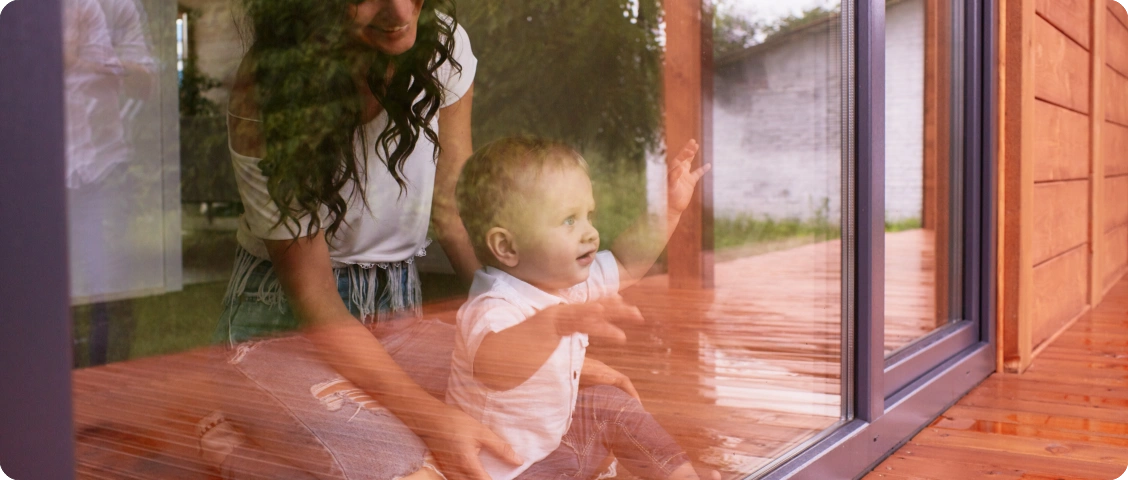
Low-E (low-emissivity) glass has a special metal coating that pushes back infrared heat from the sun. It keeps rooms cooler and reduces pesky glare.
How Low-E Glass Works Its Magic
Low-E glass uses a thin metal or metal oxide layer to target parts of sunlight that cause heat or discomfort. It blocks a lot of bright light and near-infrared rays, cutting down glare from direct sun. Meanwhile, it lets softer, natural light through, so rooms stay bright and pleasant. This makes Low-E glass a favorite for keeping spaces cool and comfy while balancing shading and light.
Shading and Energy Savings: Single-Silver, Double-Silver, Triple-Silver Low-E
Single-silver Low-E provides decent shading with an SC of about 0.43-0.61. It’s budget-friendly for milder climates. Double-silver Low-E, with two silver layers, ramps up shading (SC as low as 0.31) and lowers U-values (around 1.3-1.4 W/m²·K in a 6+12A+6 argon-filled setup). It’s perfect for hot areas. Triple-silver Low-E blocks even more heat, ideal for major energy savings, but it costs more.
Great Results with Insulated Glass
Pairing Low-E coatings with insulated glass delivers shading and insulation perks. The Low-E layer pushes away infrared heat, reducing heat buildup and glare. The insulated gap stops heat from moving between inside and outside (U-value as low as 1.4 W/m²·K), keeping rooms warm in winter. Add argon gas and solid desiccants, and you get better soundproofing and no foggy windows. It’s a great fit for busy spots like subways, airports, or offices needing top comfort and efficiency.
Low-E Glass Drawbacks
Low-E glass is awesome but needs careful handling. Its offline coatings can rust, so they must be sealed in insulated glass units. In some lighting, you might spot slight color shifts or reflections. For shading, Low-E glass balances light and energy savings, but it’s not as strong as super reflective glass. Single-silver Low-E has a higher SC, so it struggles in intense sun. Double- or triple-silver versions boost shading while keeping good light, but they’re pricier. GLASVUE’s advanced coatings fix these issues, offering stellar sun control.
Heat-Reflective Glass: Serious Sun Blocking
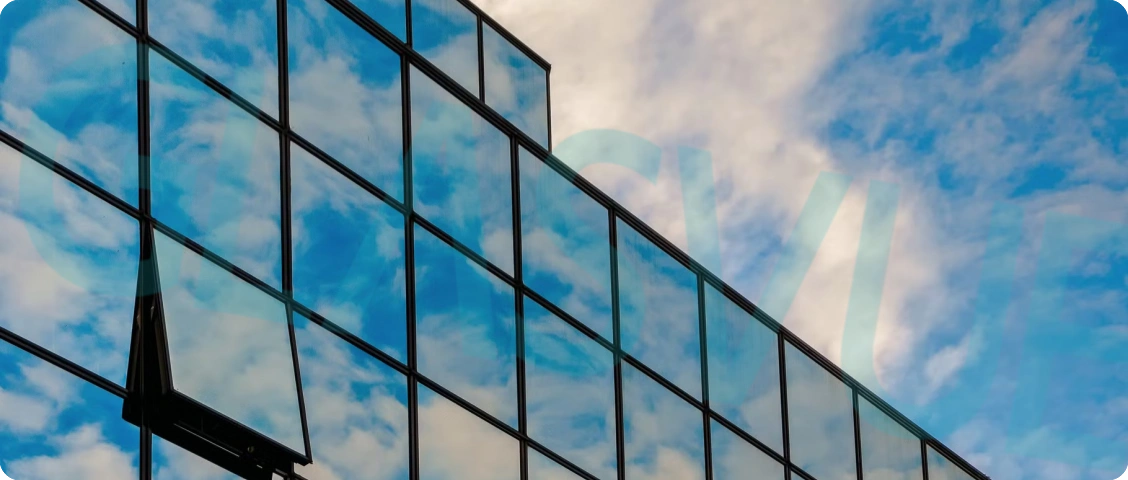
Heat-reflective glass uses a metal or metal oxide coating to strongly bounce back visible light and infrared rays. This slashes heat and glare inside rooms.
Heat-Reflective Glass vs. Low-E Glass
Compared to Low-E glass, heat-reflective glass offers bolder shading. It cuts sun heat big time, keeping spaces cool and comfy. But its shiny, mirror-like look can be a win for shading and a challenge for design, as it might not match every building’s style.
Colored Glass: Shading with a Touch of Color
Tinted glass soaks up sunlight with colored layers or materials, cutting heat and glare without coatings. It’s great for both looks and function. GLASVUE offers lots of color options for custom designs.
Tinted Glass Substrates

Body-tinted glass, like GLASVUE’s gray or green choices, absorbs 40-60% of solar energy, with an SC of 0.5-0.7. It blocks sun heat, cools rooms, and softens glare for calm lighting. Built tough and fade-resistant, it’s perfect for home windows needing privacy and cooling.
Colored Interlayer Laminated Glass
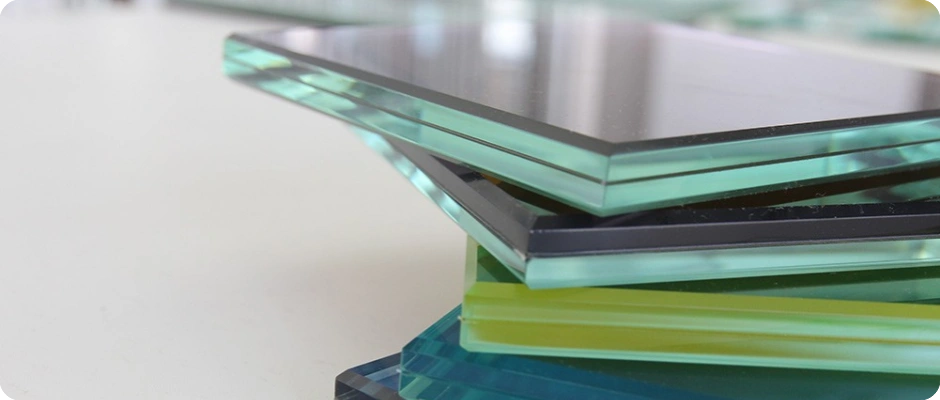
Colored laminated glass uses a PVB layer between tinted glass sheets. The tinted glass grabs and filters sunlight, while the PVB layer cuts heat even more, lowering room temps and glare. Its SC is usually 0.4-0.6, managing sun heat while letting in some natural light.
Other Neat Ways to Control Sunlight
Ceramic Frit Glass
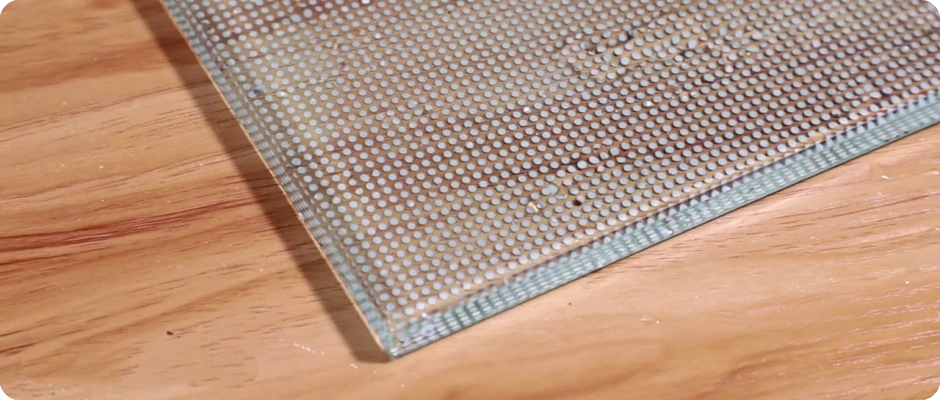
Ceramic frit glass has baked-on color patterns that reflect and absorb sunlight, blocking up to 70% of solar heat when fully covered. Its cool designs provide strong shading and can be tailored to fit a building’s look, mixing style with function.
Insulated Glass with Built-in Blinds
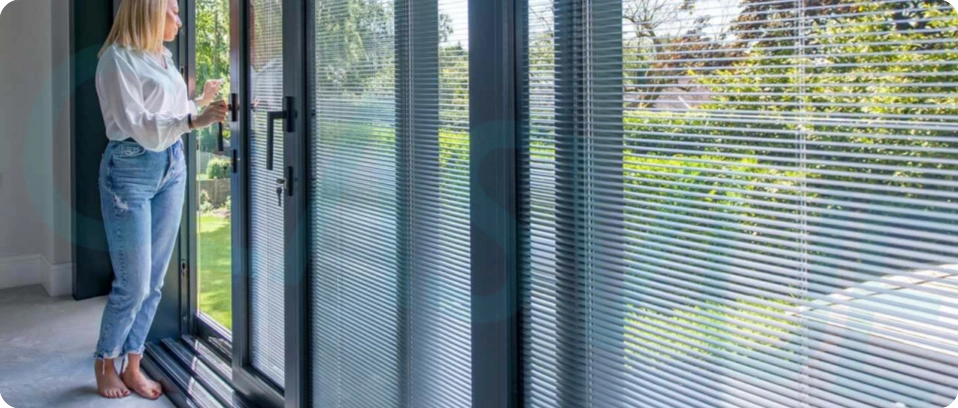
GLASVUE’s built-in blind insulated glass has adjustable aluminum or glass blinds inside the insulated gap. You can tilt them to block direct sun or strong infrared rays, cooling rooms and cutting glare. Unlike outdoor shades, it keeps the building’s exterior clean while saving energy and insulating well.
Smart Switchable Glass
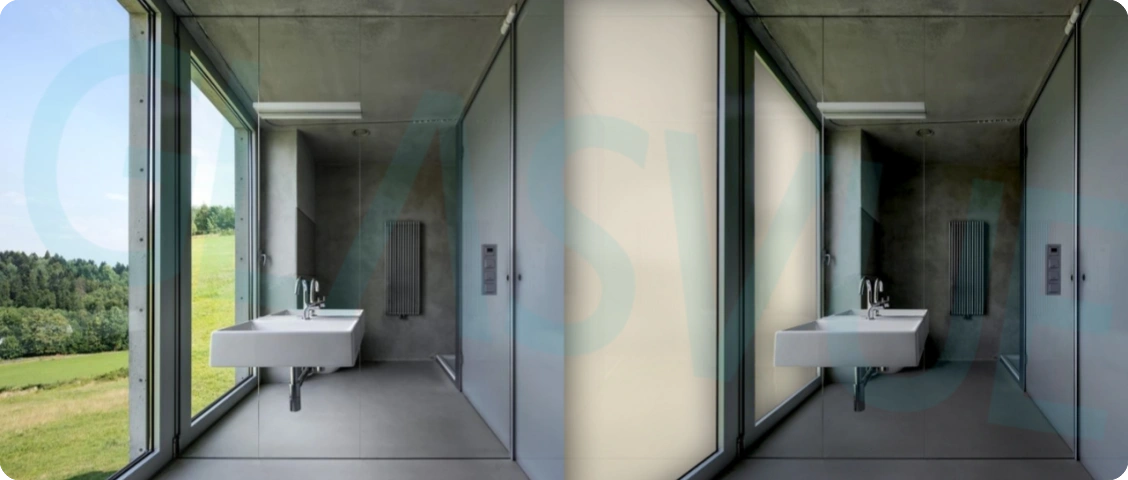
Smart glass, like electrochromic or PDLC, changes its tint when you want, tweaking how much sun it blocks. It’s pricey but saves energy, making it a great pick for fancy projects.
Picking the Right Glass for Your Project
Choosing Based on Climate: Hot or Cold Areas
Hot Areas: Pick glass with a low SC (≤ 0.4), like double-silver Low-E insulated glass or heat-reflective glass, to block heat and cut cooling costs. Colored laminated glass adds shading and safety.
Cold Areas: Go for high-transmittance Low-E glass (SC > 0.5) to let in sunlight for warmth and lighting.
Choosing Based on Building Type: Homes, Offices, Curtain Walls, Public Spaces
- Homes: Low-E insulated glass is great for privacy and soft lighting.
- Offices: Smart dimming glass or Low-E insulated glass boosts light, comfort, and energy savings.
- Curtain Walls: Colored laminated or Low-E laminated glass offers strength, safety, and a sleek look.
- Public Spaces (e.g., malls, museums, hospitals): Ceramic frit or laminated safety glass brings style, toughness, and protection.
Choosing Based on Owner Needs: Energy, Design, or Control
Energy-savvy folks love argon-filled Low-E insulated units. Design fans pick frit or tinted glass for flair. Those wanting flexibility choose switchable glass.
Why GLASVUE Is Your Best Bet for Glass
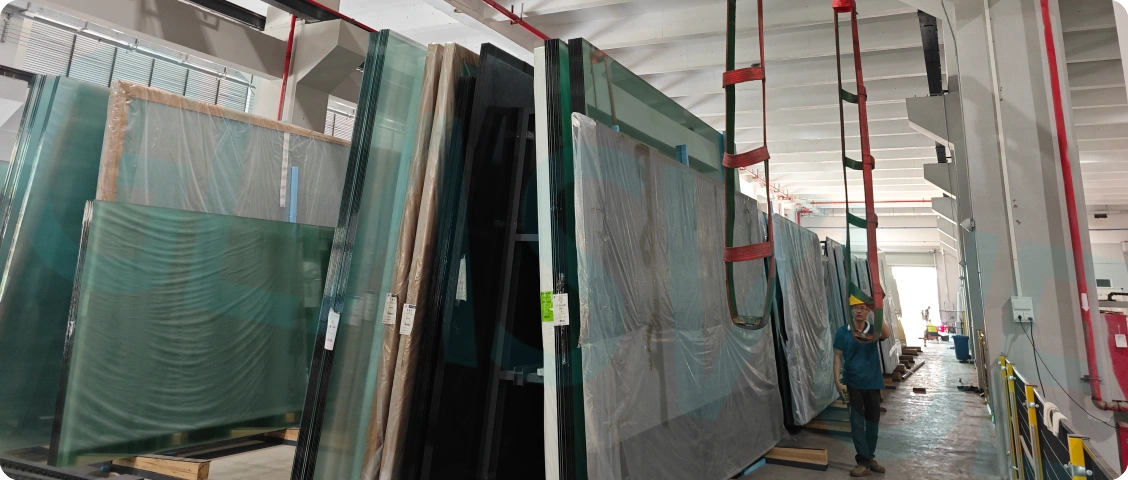
At GLASVUE, we aim high with trusted tools like the GLASTON insulated production line and GLASTON tempering furnaces. Our talented team delivers amazing results. Our glass powers big projects across China and ships to Europe, America, and Southeast Asia.
Our Commitment to Quality and Fresh Ideas
Our motto, “Breakthrough Innovation, Constantly Surpassing Higher Goals,” keeps us going. We use global tech to deliver top-notch Low-E and insulated glass.
Support from Start to Finish
From design tips to after-sales help, our pro team is quick to respond. We’re backed by CCC, US, Australian, and EU certifications for trust and quality.
Get in Touch for Custom Glass Solutions
Ready to tackle sunlight? Reach out to GLASVUE at info@glasvue.com for solutions made just for you.
FAQs
Q: Why is Low-E glass so great for blocking sun in hot places?
A: Low-E glass pushes back infrared rays but lets visible light through. It cuts heat gain by up to 85%. Our double-silver Low-E, with an SC of about 0.31, rocks in tropical climates.
Q: Can tinted glass team up with other types for better results?
A: You bet. Tinted glass can pair with Low-E coatings, insulated glass, or laminated glass to boost insulation, UV protection, and safety while looking cool. Our energy-saving products show it off.
Q: How does GLASVUE make sun-blocking glass last?
A: We use tough quality checks, certifications, and modern gear in our 40-acre factory. Our glass holds up in rough conditions with almost no wear or fading.



